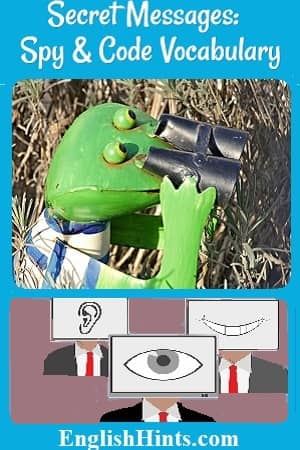Secret Messages: Spy & Code Vocabulary
Have you ever wondered how governments code secret messages to prevent enemy nations from learning their plans? How do their opponents sometimes break those codes and gain a critical advantage?
Do you enjoy reading spy stories, but find the vocabulary difficult?
You can learn some of that vocabulary here. Then you can look at a few fascinating stories that will help you remember the new words.
After links to the spy stories, read about secret codes and people who developed or decoded them. Finally, there’s a Secret Messages Crossword. (Use the links above to take you to each section.)
Espionage & Secret Message Vocabulary Explained
First, here are a few intelligence agency acronyms used in these articles. (Acronyms are names made up of the first initials of words.)
- The CIA (Central Intelligence Agency) is the foreign spy agency of the United States.
- The FBI (Federal Bureau of Investigation) tracks criminal, spy, or terrorist activity within the U.S.
- The KGB was the USSR’s security and spy agency during the Cold War. (It was the agency opposing the CIA in the Moscow articles below.)
- M15 & M16 are British counterintelligence and security agencies mentioned in some of stories of spying during world War II below.
- The SOE (Special Operations Executive) was a British agency that conducted spying and sabotage in German-occupied Europe during World War II.
- The OSS (Office of Strategic Services) was the main U.S. spy agency in World War II. (When it was shut down, its spy operations became the basis for the CIA.)
To bug is to install electronic devices in a building, on a phone line (or elsewhere*) to listen in (eavesdrop) on the conversations of enemies or rivals.
Diplomatic embassies located in enemy nations often find their host company has tried to bug their embassies. The host countries may also suspect that some diplomatic staff are spies.
*Unlikely objects can be bugged. The Mental Floss article linked below mentions a bugged coat and typewriter keys.
A cipher is a number or other symbol used in code—or more recently the key that enables decoding. ‘Cipher’ comes from the Arabic word for zero.
A code is a set of rules for secret messages. Codes allow people to send communications that their own side can read using a special key or decoder. Their enemies or rivals cannot understand the code without it.
In wartime governments work tirelessly to invent codes that enemy codebreakers cannot figure out.
(Another meaning of code is a set of principles to live by. For example, a school’s honor code might include rules that forbid cheating on exams.)
To code can mean to write instructions for computers in a “language” they understand.
A dissident is someone who opposes ('dissents' from) policies of their government.
To encode is to translate a message into a special code, and to decode is to translate it back into normal words.
To encrypt and decrypt mean the same as en- and decode.
A cryptographer works to figure out (decode) the secret messages of enemy nations. (Crypto comes from the Greek, and then the Latin, word for something hidden.)
Espionage is a formal word for spying.
A handler is the person who manages a network of spies.
To infiltrate is to secretly enter enemy territory (often to spy or cause damage).
Informants are people who provide a spy agency with information that they claim is true.
Intelligence can mean information collected by spying, (as well as intellectual ability).
To intercept is to obtain an enemy message before it can reach the people it was intended for.
An operative is a person carrying out their agencies’ secret operations. (We don’t use the word for people doing for an agency’s routine or normal business.)
Surveillance means keeping a close, constant watch on someone.
The Ducksters (children's) website has an excellent explanation in very simple English on the purposes of spying and spy agencies during World War II.
Practice this vocabulary for spying and secret messages with a crossword puzzle.
Spy Stories from World War 2 Europe
The articles linked below tell some astonishing stories. They also give you the chance to see (&/or hear) this spy vocabulary in use.
The Guardian has short accounts of 10 of the best spies. They cover World Wars I & II and the Cold War. They also discuss Belle Boyd (a spy for the Confederates during the American Civil War) and Queen Elizabeth I’s spymaster from the 1500s.
The Atlantic article is longer. It gives the nail-biting details about the women who spied for the Allies during World War II, especially those in occupied France.
Working with or in the French Resistance, the women took astonishing risks. Their work saved countless lives of French and British civilians and Allied soldiers.
Virginia Hall was an American spy with a wooden leg she called ‘Cuthbert.’ Posing as a newspaper reporter, Hall was actually a liaison officer. She had the risky task of connecting with the Resistance in Lyon. (She did not know anyone there when she arrived.)
She accomplished more than her handlers had even hoped she could. Then she was arrested, managed to escape, and finally was ‘exfiltrated’ from France. (Exfiltrated is the opposite of ‘infiltrated.’ The British got her out.)
Just before D-Day, she returned to France. There she worked with the Resistance to cut German communication lines. She also resumed spying. The Atlantic article tells how she sold cheese as a milkmaid so she could listen to th German Seventh Army. The information she got helped with the Allied liberation of Paris.
Jeannie Rousseau was a brilliant woman with a photographic memory. She worked as a translator for the Germans in France.
Rousseau said later, “’I could not but hear what was said. And what they did not say, I prompted.” At one point they showed her plans for the top-secret new rockets the Germans were developing. She memorized them and later wrote down everything she had seen.
She could only hope the British would believe the message she sent at such risk.
They did believe it. They destroyed the German factory at Peenemunde before it could produce those terrible rockets.
Later Rousseau was captured and sent to a concentration camp. The story of her survival there is also hard to believe.
(A Washington Post interview tells the whole story of her career as a spy, her survival, and her quiet life afterward. It’s long (almost 5,000 words), though the English isn’t hard. (I checked. It's mostly very common words, and you’ve just learned many of the rest.)
I hesitated to include it because of the length, but it’s an unforgettable tale if you can find the time for it.
A Disabled Filipina Spy in WW2
When the American forces were able to return to the Philippines near the end of World War 2, the Japanese soldiers had laid land mines along their route to Manila, hoping to kill as many of them as possible.
The Philippine Resistance had been able to map where the land mines were. They asked Josefina Guerrero, a young Filipina spy, to try to get the map to the Americans.
It was a very dangerous mission, even though the Japanese often didn't take Josefina, a fruit seller, seriously. Josefina also had leprosy, a terrible disease which left her weak and scarred, since the war prevented her from getting the medicine that could keep it under control. She could usually keep Japanese soldiers at a distance by warning of her leprosy.
In the past she had hidden messages in her socks,among the fruits she carried, or even in her hair. This time it was taped between her shoulder blades on her back, over some of the sores from her leprosy.
After a very difficult walk, (and a boat ride in which she was chased by pirates), she arrived at the American camp-- and found they had already left. When she finally reached them, they questioned her, but finally let her deliver the message. You can read the details and outcome of her story here.
The CIA 'Party Girl'
NPR tells the story of the CIA in Moscow during the Cold War. It focuses on one agent who pretended to be a simple party-loving embassy office worker (and her CIA spymasters).
Tony and Jonna Mendez were real-life equivalents of the fictional “Q." They recently got clearance to publish a book about their story—just before Tony died of cancer. Their lives were amazing! Tony also helped rescue American diplomats when the Iranians captured the American embassy in 1980.)
To find out what happened to ‘Party Marti’ you’ll need to read the article.
You can listen to it (it’s about 7 1/2 minutes) instead of reading it—but doing both is excellent English practice!
Decoders & Code Talkers
The Smithsonian has an article on American women codebreakers during and after World War II. The government agencies responsible for decoding were reluctant to hire them at first. In the end, they proved their value to the war effort.
Codebreaking is a very slow process that can often result in dead ends, even after months of work. The description of their persistence and occasional genius is fascinating.
I was even more interested to learn about the Navajo Code Talkers. Navajo is a difficult language that few outsiders know. That made it an ideal base for the Marines' communication system in the Pacific during World War II.
Navajo Code Talkers kept the leaders of different Marine units informed about troop movements and battles. Their code prevented the Japanese from learning that important information.
They used the Navajo language to design their code. Then they added code words for military equipment using Navajo names for different animals and birds. (The names of different birds stood for different types of aircraft.)
Code Talkers were attached to individual Marine units, so they could safely pass secret messages from one unit to another. The Japanese were never able to crack the code. The Code Talkers’ Commanding Officer said that without them, the Marines could not have won the fight for Iowa Jima.
Most Americans knew nothing about their activities until years after the war. Once the government declassified the operation (removed its secret status), it became a legend.
Hiding Messages in Knitting-- or Music
There are other ways to code. As an article in Atlas Obscura says, "Knitting, spying and secret messages so often go hand-in-hand..." It describes knitting spies from the American Revolution to World War 2 and beyond. In Belgium during World War 2, women near train yards noted German movements for the Resistance. They might use a dropped stitch "for one sort of passing train, and purling a stitch, which forms a bump in the fabric, for another."
During the Cold War Merryl Goldberg, a young Jewish-American saxophone player, and some friends wanted to visit the Phantom (ghost) Orchestra-- Soviet dissident musicians who hoped to leave the USSR. The young musicians realized they would probably be searched, so they could not simply carry the names and addresses of those they wanted to see.
Merryl figured out a way to code the data using musical notation, so it looked to a non-musician just like the rest of the hand-written sheet music she carried. (The article explains her code, in case you're interested.)
Their luggage, including her music notebook, was thoroughly searched, but the government agents never found the code. The young people did have an opportunity to play with the Phantom Orchestra. (They said the kids' visit was worth it, even though some of the dissident musicians were arrested for it later.)
The young people were also expelled from the Soviet Union before their trip was over-- but the code was never discovered.
Spy, Codes, & Decoding Vocabulary Practice
You can download a Spies & Secret Messages Crossword here. Its answers are here.
Related Pages:
Crossword Puzzles are a great way to make vocabulary study more fun. These can be printed for practice offline.
Learn and practice the words for truth-- and for various forms of falsehood.
You can review (or learn) & practice a lot of academic vocabulary in this 1961 Kennedy speech.
Home > Learn English Vocabulary > Secret Messages.
Didn't find what you
needed? Explain what you want in the search box below.
(For example, cognates, past tense practice, or 'get along with.') Click to see the related pages on EnglishHints.
| site search by freefind | advanced |











New! Comments
What do you think about what you just read? Leave me a comment in the box below.